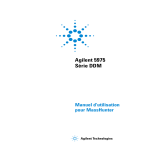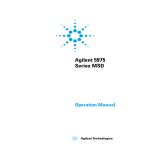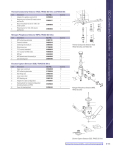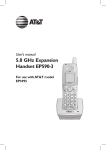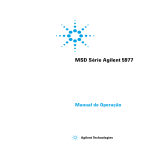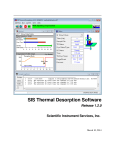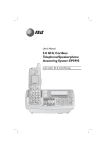Download Agilent Technologies 3589A GP-IB Stereo System User Manual
Transcript
5975 Series Site Prep.book Page 1 Thursday, January 31, 2008 9:47 AM 5975 Series Mass Selective Detectors Site Preparation Guide Agilent Technologies 5975 Series Site Prep.book Page 2 Thursday, January 31, 2008 9:47 AM Notices © Agilent Technologies, Inc. 2008 Warranty No part of this manual may be reproduced in any form or by any means (including electronic storage and retrieval or translation into a foreign language) without prior agreement and written consent from Agilent Technologies, Inc. as governed by United States and international copyright laws. The material contained in this document is provided “as is,” and is subject to being changed, without notice, in future editions. Further, to the maximum extent permitted by applicable law, Agilent disclaims all warranties, either express or implied, with regard to this manual and any information contained herein, including but not limited to the implied warranties of merchantability and fitness for a particular purpose. Agilent shall not be liable for errors or for incidental or consequential damages in connection with the furnishing, use, or performance of this document or of any information contained herein. Should Agilent and the user have a separate written agreement with warranty terms covering the material in this document that conflict with these terms, the warranty terms in the separate agreement shall control. Manual Part Number G3170-90001 Edition Second edition, January 2008 Printed in USA Agilent Technologies, Inc. 5301 Stevens Creek Boulevard Santa Clara, CA 95052 Acknowledgements Microsoft® and Windows® are U.S. registered trademarks of Microsoft Corporation Safety Notices CAU TI O N A CAUTION notice denotes a hazard. It calls attention to an operating procedure, practice, or the like that, if not correctly performed or adhered to, could result in damage to the product or loss of important data. Do not proceed beyond a CAUTION notice until the indicated conditions are fully understood and met. WA RN ING A WARNING notice denotes a hazard. It calls attention to an operating procedure, practice, or the like that, if not correctly performed or adhered to, could result in personal injury or death. Do not proceed beyond a WARNING notice until the indicated conditions are fully understood and met. Site Preparation Guide 5975 Series Site Prep.book Page 3 Thursday, January 31, 2008 9:47 AM Contents 1 General Information Instrument Identification 6 5975 MSD versions 6 Important Safety Warnings 7 Many internal parts of the MSD carry dangerous voltages Electrostatic discharge is a threat to MSD electronics 8 Many parts are dangerously hot 8 Hydrogen Safety 9 Chemical Safety 10 7 Safety and Regulatory Certifications 11 Information 11 Symbols 12 Electromagnetic compatibility 13 Sound emission declaration 13 Cleaning 14 Recycling the Product 2 14 Site Preparation Overview 16 Customer responsibility 16 Agilent responsibility 17 Other documentation 19 Space and Weight Requirements Communications Requirements Telephone 22 Site LAN network 22 Electrical Requirements Site Preparation Guide 20 22 23 3 5975 Series Site Prep.book Page 4 Thursday, January 31, 2008 9:47 AM Voltage ranges of major components Power configurations 24 Power requirements 25 Power plugs and cord 26 Other electrical considerations 27 23 Air Conditioning and Environmental Requirements Temperature, humidity, and altitude 28 Airborne dust 29 Exhaust venting 29 Fume (exhaust) hood 30 28 Carrier and Reagent Gas Requirements 31 Regulators, tubing, and fittings 32 Laboratory Supply Requirements Cleaning solvents 33 Data system supplies 33 Spare parts and consumables 33 34 Receiving the System 37 Delivery and unloading 37 Inspecting for damage 37 Storage 38 Unpacking 38 Installation and Verification Installation 39 Verification 39 Sensitivity specifications A 4 39 40 Power Cords Site Preparation Guide 5975 Series Site Prep.book Page 5 Thursday, January 31, 2008 9:47 AM 5975 Series Mass Selective Detectors Site Preparation Guide 1 General Information Instrument Identification 6 Important Safety Warnings 7 Hydrogen Safety 9 Chemical Safety 10 Safety and Regulatory Certifications 11 Cleaning 14 Recycling the Product 14 This section provides information on how to identify specifically what type of MSD you are working with as well as how to properly clean and dispose of the instrument. Also included in this section are the “Important Safety Warnings” which list critical safety precautions for all users. Agilent Technologies 5 5975 Series Site Prep.book Page 6 Thursday, January 31, 2008 9:47 AM General Information Instrument Identification Each 5975 Series Mass Selective Detector (MSD) is identified by a unique 10-character serial number. This serial number is located on a label on the lower left side near the front of the instrument. On CI upgrades, a second serial number is located on the flow module. When corresponding with Agilent Technologies about your instrument, be sure to include the model number and both full 10-character serial numbers. Write the serial number of your 5975 MSD here for reference: 5975 MSD versions Table 1 shows the kinds of 5975 MSDs available. The product number on the serial number label identifies your MSD. Table 1 5975 MSD versions Model number Product number Pump type Ionization mode 5975 VL MSD G3170A Diffusion Electron Impact (EI) only 5975 inert MSD G3171A Standard turbo Electron Impact (EI) only G3172A Performance turbo Electron Impact (EI) only G3174A Performance turbo Electron Impact (EI) Negative Chemical Ionization (NCI) Positive Chemical Ionization (PCI 5975 inert XL MSD This site preparation guide will refer to 5975 Series MSDs unless noted otherwise. 6 Site Preparation Guide 5975 Series Site Prep.book Page 7 Thursday, January 31, 2008 9:47 AM General Information Important Safety Warnings Before moving on, there are several important safety notices that you should always keep in mind when using the 5975 Series Mass Selective Detector. Many internal parts of the MSD carry dangerous voltages If the MSD is connected to a power source, even if the power switch is off, potentially dangerous voltages exist on: • The wiring between the MSD power cord and the AC power supply, the AC power supply itself, and the wiring from the AC power supply to the power switch. With the power switch on, potentially dangerous voltages also exist on: • All electronics boards in the instrument. • The internal wires and cables connected to these boards. • The wires for any heater. WA RN ING All these parts are shielded by covers. With the covers in place, it should be difficult to accidentally make contact with dangerous voltages. Unless specifically instructed to, never remove a cover unless the detector, inlet, or oven are turned off. WA RN ING If the power cord insulation is frayed or worn, the cord must be replaced. Contact your Agilent service representative. Connecting the MSD to power sources that are not equipped with protective earth contacts creates a shock hazard for the operator and can damage the instrument. Interrupting the protective conductor inside or outside the MSD or disconnecting the protective earth terminal creates a shock hazard for the operator and can damage the instrument. Make sure the power cords supplied with the MSD are appropriate for your country and site before using them. Maintain easy access to the power cords so they can be disconnected during maintenance. Site Preparation Guide 7 5975 Series Site Prep.book Page 8 Thursday, January 31, 2008 9:47 AM General Information The use of incorrect or makeshift fuses or the short-circuiting of fuse holders creates a shock hazard for the operator and can damage the instrument. Replace fuses only with fuses of identical current rating and type. Excessive fluctuations in the line voltage can create a shock hazard and can damage the instrument. Make sure the supply voltage does not fluctuate more than +5% or -10% from the rated voltage. This equipment must be installed in a Category II environment as defined in IEC 664. Electrostatic discharge is a threat to MSD electronics The printed circuit (PC) boards in the MSD can be damaged by electrostatic discharge. Do not touch any of the boards unless it is absolutely necessary. If you must handle them, wear a grounded wrist strap and take other antistatic precautions. Wear a grounded wrist strap any time you must remove the MSD covers. Many parts are dangerously hot Many parts of the MSD operate at temperatures high enough to cause serious burns. You should always cool heated areas of the MSD to room temperature before working on them. They will cool faster if you first set the temperature of the heated zone to room temperature. Turn the zone off after it has reached the setpoint. If you must perform maintenance on hot parts, use a wrench and wear gloves. Whenever possible, cool the part of the instrument that you will be maintaining before you begin working on it. 8 WA RN ING Be careful when working behind the gas chromatograph (GC). During cool-down cycles, the GC emits hot exhaust which can cause burns. WA RN ING The insulation around the GC inlets, detectors, valve box, and the insulation cups is made of refractory ceramic fibers. To avoid inhaling fiber particles, we recommend the following safety procedures: ventilate your work area; wear long sleeves, gloves, safety glasses, and a disposable dust/mist respirator; dispose of insulation in a sealed plastic bag; wash your hands with mild soap and cold water after handling the insulation. Site Preparation Guide 5975 Series Site Prep.book Page 9 Thursday, January 31, 2008 9:47 AM General Information Hydrogen Safety Hydrogen gas may be used as carrier gas, and/or as fuel for certain GC detectors. When mixed with air, hydrogen can form explosive mixtures. A detailed discussion of hydrogen safety appears in Chapter 1 of the Agilent 5975 MSD Troubleshooting and Maintenance Manual. Read this material before using hydrogen with the MSD. WA RN ING When using hydrogen (H2) as the carrier gas or fuel gas, be aware that hydrogen gas can flow into the oven and create an explosion hazard. Therefore, be sure that the supply is off until all connections are made, and ensure that the GC inlet and detector column fittings are either connected to a column or capped at all times when hydrogen gas is supplied to the instrument. Hydrogen is flammable. Leaks, when confined in an enclosed space, may create a fire or explosion hazard. In any application using hydrogen, leak test all connections, lines, and valves before operating the instrument. Always turn off the hydrogen supply at its source before working on the instrument. WA RN ING The MSD cannot detect leaks in gas streams. For this reason, it is vital that column fittings should always be either connected to a column, or have a cap or plug installed. When using hydrogen gas, check the system for leaks as described by your local Environmental Health and Safety (EHS) requirements to prevent possible fire and explosion hazards. Always check for leaks after changing a tank or servicing the gas lines. Always make sure the vent line is vented into a fume hood. Site Preparation Guide 9 5975 Series Site Prep.book Page 10 Thursday, January 31, 2008 9:47 AM General Information Chemical Safety WA RN ING 10 The foreline pump exhaust and split vent exhaust will contain traces of the chemicals you are analyzing. These could potentially be toxic. Vent the foreline pump exhaust and split vent exhaust outside your laboratory or into a fume hood. Be sure to comply with all local environmental regulations. Site Preparation Guide 5975 Series Site Prep.book Page 11 Thursday, January 31, 2008 9:47 AM General Information Safety and Regulatory Certifications The 5975 Series MSD conforms to the following safety standards: • Canadian Standards Association (CSA): CAN/CSA–C22.2 No. 61010–1–04 • CSA/Nationally Recognized Test Laboratory (NRTL): UL 61010–1 • International Electrotechnical Commission (IEC): 61010–1 • EuroNorm (EN): 61010–1 The 5975 Series MSD conforms to the following regulations on Electromagnetic Compatibility (EMC) and Radio Frequency Interference (RFI): • CISPR 11/EN 55011: Group 1, Class A • IEC/EN 61326 • AUS/NZ This ISM device complies with Canadian ICES-001. Cet appareil ISM est conforme a la norme NMB—001 du Canada. The 5975 Series MSD is designed and manufactured under a quality system registered to ISO 9001. Information The Agilent Technologies 5975 Series MSD meets the following IEC (International Electro-technical Commission) classifications: Equipment Class I, Laboratory Equipment, Installation Category II, Pollution Degree 2. This unit has been designed and tested in accordance with recognized safety standards and is designed for use indoors. If the instrument is used in a manner not specified by the manufacturer, the protection provided by the instrument may be impaired. Whenever the safety protection of the MSD has been compromised, disconnect the unit from all power sources and secure the unit against unintended operation. Refer servicing to qualified service personnel. Substituting parts or performing any unauthorized modification to the instrument may result in a safety hazard. Site Preparation Guide 11 5975 Series Site Prep.book Page 12 Thursday, January 31, 2008 9:47 AM General Information Symbols Warnings in the manual or on the instrument must be observed during all phases of operation, service, and repair of this instrument. Failure to comply with these precautions violates safety standards of design and the intended use of the instrument. Agilent Technologies assumes no liability for the customer’s failure to comply with these requirements. See accompanying instructions for more information. Indicates a hot surface. Indicates hazardous voltages. Indicates earth (ground) terminal. Indicates potential explosion hazard. or Indicates radioactivity hazard. Indicates electrostatic discharge hazard. Indicates that you must not discard this electrical/electronic product in domestic household waste. 12 Site Preparation Guide 5975 Series Site Prep.book Page 13 Thursday, January 31, 2008 9:47 AM General Information Electromagnetic compatibility This device complies with the requirements of CISPR 11. Operation is subject to the following two conditions: • This device may not cause harmful interference. • This device must accept any interference received, including interference that may cause undesired operation. If this equipment does cause harmful interference to radio or television reception, which can be determined by turning the equipment off and on, the user is encouraged to try one or more of the following measures: 1 Relocate the radio or antenna. 2 Move the device away from the radio or television. 3 Plug the device into a different electrical outlet, so that the device and the radio or television are on separate electrical circuits. 4 Make sure that all peripheral devices are also certified. 5 Make sure that appropriate cables are used to connect the device to peripheral equipment. 6 Consult your equipment dealer, Agilent Technologies, or an experienced technician for assistance. 7 Changes or modifications not expressly approved by Agilent Technologies could void the user’s authority to operate the equipment. Sound emission declaration Sound pressure Sound pressure Lp < 70 dB according to EN 27779:1991. Schalldruckpegel Schalldruckpegel LP < 70 dB am nach EN 27779:1991. Site Preparation Guide 13 5975 Series Site Prep.book Page 14 Thursday, January 31, 2008 9:47 AM General Information Cleaning To clean the unit, disconnect the power and wipe down with a damp, lint-free cloth. Recycling the Product For recycling, contact your local Agilent sales office. 14 Site Preparation Guide 5975 Series Site Prep.book Page 15 Thursday, January 31, 2008 9:47 AM 5975 Series Mass Selective Detectors Site Preparation Guide 2 Site Preparation Overview 16 Space and Weight Requirements 20 Communications Requirements 22 Electrical Requirements 23 Air Conditioning and Environmental Requirements 28 Carrier and Reagent Gas Requirements 31 Laboratory Supply Requirements 33 Receiving the System 37 Installation and Verification 39 This section describes how to properly prepare your site for a new MSD. Follow these instructions carefully as delays due to improper site preparation may result in loss of instrument use during the warranty period. Agilent Technologies 15 5975 Series Site Prep.book Page 16 Thursday, January 31, 2008 9:47 AM Site Preparation Overview Before the 5975 Series MSD system can be installed, the site must be properly prepared. Site preparation includes, but is not limited to, ensuring that adequate facilities are available. Among the site requirements are: • Adequate space is available for the MSD system. • A suitable supporting bench is available. • Adequate electrical power is available at the correct voltages and frequencies. • Environmental control systems are adequate to maintain a correct, stable operating environment. • Preparations for safe exhaust venting are adequate. • Supplies necessary for instrument operation are available, including solvents, carrier and reagent gasses, and printer paper. NO TE Installation and verification will only be performed using helium carrier gas. CI systems require methane reagent gas for verification. Delays due to inadequate site preparation could cause loss of instrument use during the warranty period. In extreme cases, Agilent Technologies may ask to be reimbursed for the additional time required to complete the installation. Agilent Technologies provides service during the warranty period and under maintenance agreements only if the specified site requirements are met. Customer responsibility Unless previous arrangements have been made with Agilent Technologies, site preparation is the customer’s responsibility. Customer responsibilities include, but are not limited to: • Planning, scheduling, and preparing the site according to the specifications in this manual • Verifying that the electrical environment is safe and adequate for the MSD system installation and operation 16 Site Preparation Guide 5975 Series Site Prep.book Page 17 Thursday, January 31, 2008 9:47 AM Site Preparation • Complying with all local laws (codes, ordinances, and regulations) for mechanical, building, and electrical distribution systems, hazardous waste disposal, and chemical storage. Compliance must exist prior to installation. • Providing lifting equipment adequate to unload the system from the delivery vehicle and transport it to the site where it will be installed • Providing someone to help lift the MSD onto the laboratory bench • Providing adequate secure storage space for the system until it can be installed by an Agilent Technologies representative Agilent responsibility An Agilent Technologies service representative will install the MSD and verify its performance. The service representative’s responsibilities are limited to: • Unpacking the MSD system and verifying that all components are present and undamaged • Connecting the carrier gas line to the instrument from the tank, regulators, and lines previously installed by the customer • Installing, connecting, and turning on MSD system components • Verifying that the system meets Agilent Technologies performance standards • Providing basic user familiarization for system hardware and software • Signing the customer up through the Response Centers for instrument and software support Site Preparation Guide 17 5975 Series Site Prep.book Page 18 Thursday, January 31, 2008 9:47 AM Site Preparation Agilent Technologies is not responsible for: • Any task not listed in the 5975 Series MSD Troubleshooting and Maintenance Manual or the installation guides for the GC, data system, and other accessories • Installing helium carrier gas or reagent gas tanks and regulators • Connecting or verifying the performance of hardware and software not provided by Agilent Technologies NO TE Items that do not include installation by Agilent Technologies must be installed by the customer. • Connecting the MSD/ChemStation system to the site network • Testing the MSD against customer standards or samples • Providing detailed instruction in the operation of the computer operating system and MSD software NO TE Contact Agilent Technologies for information concerning training classes. • Setting up laboratory procedures NO TE Contact Agilent Technologies for information concerning Application Assist or Chemical Analysis Consulting services. • Operating the MSD system following installation 18 Site Preparation Guide 5975 Series Site Prep.book Page 19 Thursday, January 31, 2008 9:47 AM Site Preparation Other documentation Additional information is contained in the following documentation: • 5975 Series MSD Troubleshooting and Maintenance Manual • 5975 Series MSD Operation manual • 6890 Series GC manuals • GC accessories (autosampler, etc.) manuals • G1701EA MSD Productivity ChemStation software manuals and online help • The appropriate sensitivity specifications for your instrument. See the Agilent Technologies website at http://www.agilent.com/chem. Site Preparation Guide 19 5975 Series Site Prep.book Page 20 Thursday, January 31, 2008 9:47 AM Site Preparation Space and Weight Requirements Table 2 lists dimension and weight information for the MSD and related components. Your site must have enough bench space for the MSD, GC, data system, and accessories (Figure 1). In addition, there must be sufficient space around the system for ventilation and maintenance access. At least 30 cm (12 inches) to the left of the MSD and at least 20 cm (8 1/4 inches) behind the MSD must be kept clear. Benches must be sturdy enough to support the weight of the entire system. The foreline pump can be located on the laboratory bench or on the floor. It must be close to the MSD because it is connected by a 200-cm (79-inch) hose. The hose is stiff and cannot be bent sharply. CAU TI O N Do not put the foreline pump on your laboratory bench if vibration-sensitive equipment is located on the bench. 5975 Series MSD 6890 Series GC Computer with monitor Printer ALS tray Figure 1 20 Top view of typical installation Site Preparation Guide 5975 Series Site Prep.book Page 21 Thursday, January 31, 2008 9:47 AM Site Preparation Table 2 Product dimensions Approximate Dimensions, cm (in) Product Height Width Depth Weight, kg (lb) • G3170A Diffusion EI MSD 41 (16) 30 (12) 54 (21) 39 (85) • G3171A Standard turbo EI MSD 41 (16) 30 (12) 54 (21) 39 (85) • G3172A Performance turbo EI MSD 41 (16) 30 (12) 54 (21) 41 (90) • G3174A EI/PCI/NCI MSD 41 (16) 30 (12) 54 (21) 46 (100) 7890 Series GC 54 (21) 59 (23) 54 (21) 50 (112) 6890 Series GC 50 (20) 58 (23) 55 (22) 50 (110) 6850 Series GC 50 (20) 29 (11) 54 (21) 23 (51) Data System Data system size and weight depend on the components included in the data system. Reserve at least 100 cm (39 in) of bench space for the data system. A typical data system weight is 34 kg (75 lb). 5975 Series MSD Be sure to allow space for your carrier and reagent gases. NO TE The values in Table 2 are for a single MSD ChemStation configuration. Two-MSD configurations require additional table space. The second GC/MSD system can be located on a different table and connected to the ChemStation with a network cable. Site Preparation Guide 21 5975 Series Site Prep.book Page 22 Thursday, January 31, 2008 9:47 AM Site Preparation Communications Requirements Telephone A telephone with a cord long enough to be used at the computer will allow the MSD operator to communicate with Agilent Technologies support personnel. Site LAN network If you intend to connect your MSD system to your site’s LAN network, you must have an additional shielded twisted pair network cable. 22 NO TE Agilent Technologies is not responsible for connecting to or establishing communication with your site LAN network. The representative will test the 5975 Series MSD’s ability to communicate on a mini-hub or -switch only. NO TE The IP addresses assigned to the instrument(s) must be fixed (permanently assigned) addresses. If you intend to connect your MSD system to your site’s network, each piece of equipment (the MSD, the GC, and the computer) must have a unique IP address assigned to it. Site Preparation Guide 5975 Series Site Prep.book Page 23 Thursday, January 31, 2008 9:47 AM Site Preparation Electrical Requirements You are responsible for providing appropriate electrical power and power outlets for all of the components in your 5975 Series MSD system. Power considerations include: • Voltage ranges of major components • Power configurations • Power requirements • Power plugs and cords Voltage ranges of major components The 5975 Series MSD includes a full-range power supply that can operate without reconfiguration on either of two wide ranges of single-phase alternating current (AC) electrical power: • 120-127 VAC 60 Hz (typical for North America) • 200-240 VAC, 50/60 Hz (typical for Europe and Japan) The foreline pump also draws its power from the MSD. However, a different foreline pump is supplied depending on the voltage range on which the MSD will be operating. The pump is supplied according to the standard voltage in the country from which the order originates. For example, if an order originates from an Agilent Technologies sales office in Germany, the foreline pump supplied will be configured to operate on the standard voltage and frequency of electrical power in Germany. NO TE The MSD does not support 100 VAC input power. In countries that have only 100 VAC power, a step-up transformer must be used to provide the appropriate voltage to the MSD. CAU TI O N If an instrument is being ordered from one location but is to be installed in another location with different electrical power characteristics, this must be noted on the order. A special note must also be made if the electrical power at the site is different from the standard electrical power in that country. Site Preparation Guide 23 5975 Series Site Prep.book Page 24 Thursday, January 31, 2008 9:47 AM Site Preparation Power configurations Electrical power for the MSD must be single-phase. The neutral wire cannot be used for safety grounding. The ground wire should carry zero current except for ground-fault current or static electric discharge. The entire system should share an isolated, noise-free electrical ground. This system ground should be electrically separate from the ground for the rest of the building, back to the main ground for the facility. Power configurations are provided in Table 3. WA RN ING Connecting an MSD to a power source which is not equipped with a protective earth contact (ground) creates a shock hazard for the operator and can damage the instrument. WA RN ING Interrupting the protective conductor inside or outside the MSD or disconnecting the protective earth terminal (ground) creates a shock hazard for the operator and can damage the instrument. Table 3 Power configurations Configuration Measurement Nominal voltage Single phase, 120-127 VAC Line to neutral 120 or 127 VAC * Line to ground 120 or 127 VAC * Ground to neutral < 0.5 V rms Line to neutral 200, 220, or 240 VAC * Line to ground 200, 220, or 240 VAC * Ground to neutral < 0.5 V rms Single phase, 200-240 VAC * Varies with country and/or region 24 Site Preparation Guide 5975 Series Site Prep.book Page 25 Thursday, January 31, 2008 9:47 AM Site Preparation Power requirements Table 4 lists the power requirements for the 5975 Series MSD and related equipment. Extra power capacity for future additions is recommended. Each product listed requires a dedicated circuit. The gauge controller is powered by the MSD. The MSD, GC, and data system must each have a separate circuit breaker. All of the equipment must share a common ground. Power must meet the stability specifications listed in Table 4. Use a line monitor to check power stability. If your line power is unstable, you may need to install a line conditioner. Table 4 Power requirements Product Line voltage Maximum continuous power consumption Supply circuit rating Outlets required 5975 Series MSD* 120-127 VAC 60 Hz 900 VA (400 VA for foreline pump only) 15 A 1 200-240 VAC, 50/60 Hz 900 VA 15 A 1 Americas: 120 VAC† single phase 2250 VA 20 A 1 220/230/240V single/split phase (-10%/+5%), 48-66 Hz 2250 VA 15 A 1 Japan: 200V split phase (-10%/+5%), 48-66 Hz 2950 VA 15 A 1 220/230/240 VAC‡ single/split phase (-10%/+5%), 48-66 Hz 2950 VA 15 A 1 America: 120 VAC, 48-63 Hz 1440 VA 15 A 1 Japan: 100 VAC, 48-63 Hz 1440 VA 15 A 1 230 VAC, 48-63 Hz 2000 VA 8-12 A 1 America: 120 VAC, 48-63 Hz 2400 VA 20 A 1 Japan: 200 VAC, 48-63 Hz 2400 VA 12 A 1 230 VAC, 48-63 Hz 2400 VA 11 A 1 7890A and 6890 GCs (standard oven) and ALS 7890A and 6890 GCs (fast oven) and ALS 6850 GC (standard oven)** 6850 GC (fast oven)** Site Preparation Guide (-10%/+5%), 48-66 Hz 25 5975 Series Site Prep.book Page 26 Thursday, January 31, 2008 9:47 AM Site Preparation Table 4 Power requirements (continued) Product Line voltage Maximum continuous power consumption Supply circuit rating Outlets required ChemStation computer 100-120 or 220-240 VAC+5/-10%, 50/60 Hz ± 5% 1000 VA 15 A 3 to 5 * The MSD operates on either voltage range. The foreline and turbo pumps are supplied for the voltage range suitable to the country where the order originates † Americas 120 V requires 20 A dedicated line. Americas 240 V requires 15 A dedicated line. ‡ Option 003, fast oven, is a unit with operating range 198 to 231 V. Most laboratories have 4-wire service resulting in 208 V at the wall receptacle. It is important to measure the line voltage at the receptacle for the GC. ** Requires an isolated ground and dedicated outlet. Power plugs and cord The MSD is supplied with a power cord and plug appropriate for the country from which the order originates. For example, if an order originates from a Agilent Technologies sales office in Germany, the power cord and plug supplied will be compatible with the standard voltage and outlet configuration in Germany. See “Power Cords" on page 41 for illustrations of the power cords available. Data system components also include power cords with plugs appropriate for the country where the order was placed. Power cord lengths for the MSD and the data system components and accessories are approximately 2.3 m (7.5 ft). 26 CAU TI O N If an instrument is being ordered from one location but is to be installed in another location with different electrical power characteristics, this must be noted on the order. A special note must also be made if the electrical power at the site is different from the standard electrical power in that country. WA RN ING Make sure the power cords supplied with the MSD are appropriate for your country and site before installing the instrument. See “Power Cords” on page 41. Site Preparation Guide 5975 Series Site Prep.book Page 27 Thursday, January 31, 2008 9:47 AM Site Preparation WA RN ING Do not use extension cords with the MSD or GC. Extension cords normally are not rated to carry enough power and can be a safety hazard. NO TE Maintain easy access to the power cords so they can be disconnected for maintenance. Other electrical considerations Additional electrical considerations include: • Electromagnetic interference (EMI), such as is generated by NMRs, radio transmitters, and microwave links, may interfere with system performance. • Protect the system from static electricity by observing humidity and temperature requirements. Minimize the presence of nonconductive products such as carpets and vinyl floor tiles. • Install emergency-off pushbuttons that can disconnect power to the ventilation system and all electric equipment in the room except overhead lighting. • Provide separate convenience outlets for building maintenance and other appliances. Convenience outlets must be on circuits separate from the MSD system. Convenience outlets must share the normal building distribution ground, not the MSD system ground. • In some geographical areas it may be advisable to install lightning protection for personnel and equipment. Site Preparation Guide 27 5975 Series Site Prep.book Page 28 Thursday, January 31, 2008 9:47 AM Site Preparation Air Conditioning and Environmental Requirements Air conditioning considerations include temperature, humidity, airborne dust, and exhaust venting. Each of these is considered in more detail in the following material. Temperature, humidity, and altitude The 5975 Series MSD is specified for operation under the following conditions: • Operation requires constant temperature (variations <2 °C/h) • Operation and storage require a noncondensing, noncorrosive atmosphere • The temperature and humidity limits in Table 5 • Maximum altitude for operation: 2300 m (7500 ft) Table 5 Temperature and humidity limits Temperature Humidity (relative) Operation 15 °C to 35 °C (59 °F to 95 °F) 40% to 80% Storage –20 °C to 70 °C (–4 °F to 158 °F) 0% to 95% Environmental control systems must maintain these temperature and humidity ranges. The MSD is rated for 1200 Watts (4000 BTU/h). The GC and the data system also contribute significantly to the cooling load although the exact amounts depend on their configurations. Additional allowances should be made for other heat sources such as heat from other equipment, heat from adjacent rooms, and heat from laboratory personnel. 28 Site Preparation Guide 5975 Series Site Prep.book Page 29 Thursday, January 31, 2008 9:47 AM Site Preparation Airborne dust Agilent Technologies recommends a maximum airborne particle density of 55 μg/m3. If you suspect your site exceeds this limit, contact your local Agilent Technologies Customer Service Organization. Customer Engineers with special training and equipment can test for airborne particle density. They can offer suggestions for reducing airborne dust. Exhaust venting There are two sources of exhaust on the GC/MSD system: the foreline pump and the GC split vent. The foreline pump outputs gas removed from the vacuum manifold by the high vacuum pumps. The foreline pump exhaust will also contain traces of solvent and sample. WA RN ING User safety requires that the exhaust gases from the MSD be vented externally to the building and not recirculated by the environmental control system. Health hazards include chemical toxicity of solvents, samples, derivitizing agents, pump fluid vapor, and aerosolized biological samples. WA RN ING The pump exhaust contains carrier gas and traces of solvents, analytes, and foreline pump oil. The supplied oil trap stops only pump oil. It does not trap or filter out toxic chemicals. If you are using toxic solvents or toxic or flammable carrier gas, or analyzing toxic chemicals, do not install the oil trap. Install a hose to take the pump exhaust to a fume hood. Do not use the oil trap on any CI MSD. The foreline pump exhaust cannot be vented into the laboratory if any hazardous materials will be introduced into the GC/MS system, including samples, solvents, carrier gases, and reagent gases. It must be vented external to the building or vacuum exhausted to a fume hood. If a negative pressure vent is not available, the length of tubing from the foreline pump to an ambient pressure vent should not exceed 460 cm (15 ft). The exhaust can not be connected to a positive pressure vent. Exhaust gas venting must comply with all local environmental and safety codes. Site Preparation Guide 29 5975 Series Site Prep.book Page 30 Thursday, January 31, 2008 9:47 AM Site Preparation See your GC manuals for information on venting the split vent. Fume (exhaust) hood An auxiliary work space and fume hood are needed for some maintenance procedures. 30 Site Preparation Guide 5975 Series Site Prep.book Page 31 Thursday, January 31, 2008 9:47 AM Site Preparation Carrier and Reagent Gas Requirements Table 6 lists the specifications for the carrier and reagent gases. Pressures and flows are as measured at the bulkhead fittings on the back of the instrument, not at the gas supply. We recommend that additional shut-off valves be installed near the instruments. Table 6 Carrier and reagent gas requirements Purity Typical pressure range, kPa (psi) Typical flow, mL/min Helium (required) 99.9995% or better and hydrocarbon-free 345 to 550 (50 to 80) 20 to 50 (column and split flow) Methane reagent gas (required for CI operation) Research or SFC grade, 99.999% 103 to 172 (15 to 25) 1 to 2 Isobutane reagent gas (optional) Instrument grade, 99.99% 103 to 172 (15 to 25) 1 to 2 Ammonia reagent gas (optional) Research or SFC grade, 99.9995% 34 to 55 (5 to 8) 1 to 2 Carbon dioxide reagent gas (optional) SFC Grade, 99.995% 103 to 138 (15 to 20) 1 to 2 WA RN ING Methane is flammable and ammonia is corrosive and toxic. Read and follow the safety information that comes with the gases. Site Preparation Guide 31 5975 Series Site Prep.book Page 32 Thursday, January 31, 2008 9:47 AM Site Preparation Regulators, tubing, and fittings You must supply appropriate regulators for your carrier and reagent gas. • Regulators must be dual-stage. • Regulators must have stainless-steel (not elastomeric) diaphragms. • They must supply gas at the pressure specified. • They must have one outlet with 1/4-inch Swagelok fittings. See the Agilent Technologies Chemical Analysis Columns and Supplies Catalog or visit the Agilent Technologies Chemical Analysis website at http://www.agilent.com/chem for dual-stage regulators available from Agilent Technologies. You must supply Swagelok or Swagelok-compatible fittings, ferrules, and connectors for the 1/8-inch tubing. 32 Site Preparation Guide 5975 Series Site Prep.book Page 33 Thursday, January 31, 2008 9:47 AM Site Preparation Laboratory Supply Requirements Laboratory supply requirements vary with applications. Cleaning solvents Cleaning tasks for the MSD require the following HPLC-grade (or better) solvents: • Methylene chloride • Isopropyl alcohol • Methanol • Acetone • Water Proper storage, handling, and disposal of these chemicals is required for personal and environmental safety. CAU TI O N Do not use carbon disulfide as a cleaning solvent on or around the MSD. It is corrosive and will damage the analyzer. Use of carbon disulfide as a cleaner will void the warranty on the analyzer. Carbon disulfide may be used as a sample solvent in standard size injections (typically 2 µL or less). WA RN ING Chemical solvents should be considered hazardous and must be handled with care. Contact your chemical supplier for solvent handling and safety information, preferably a material safety data sheet (MSDS). Data system supplies You will need paper for printing the results of the testing done during installation and later for printing reports of your analyses. You will also need appropriate supplies for making backup copies of your data files. Site Preparation Guide 33 5975 Series Site Prep.book Page 34 Thursday, January 31, 2008 9:47 AM Site Preparation Spare parts and consumables The supplies and parts listed in Table 7 are used in the operation and maintenance of a 5975 Series MSD system. Keeping these parts on hand can reduce system downtime related to instrument maintenance and repair. Table 7 Maintenance supplies and consumables Description Part number Miscellaneous consumables One-year maintenance kit 5183-0296 He/H2 gas filter for GC 5182-3468 Abrasive sheets (5/pk) 5061-5896 Cloths, lint-free (15/pk) 05980-60051 Cotton swabs (100/pk) 5080-5400 2,4,6-tris(perfluoroheptyl)-1,3,5-triazine (PFHT) Foreline pump oil, Inland 45, 1 liter 6040-0834 EI filament (2/pk) 05972-60053 EI high temp filament G2590-60053 Octafluoronapthalene (OFN) 8500-5441 Gloves, clean large 8650-0030 small 8650-0029 Nitrile rubber gloves, medium 9300-1751 Filaments 34 CI (2/pk) G1099-80053 EI high temp filament G2590-60053 Site Preparation Guide 5975 Series Site Prep.book Page 35 Thursday, January 31, 2008 9:47 AM Site Preparation Table 7 Maintenance supplies and consumables (continued) Chemical Consumables PFTBA (EI calibration fluid) 05971-60571 PFDTD (CI calibration fluid) 8500-8130 EVAL A (evaluation sample) 05990-60045 OFN (Octafluoronapthalene) 5188-5348 OFN 100 fg/µL 5188-5347 Benzophenone 8500-5440 PFHT 5188-5357 Foreline pump oil, P3, 0.5 liter 6040-0621 Gas Filters He/H2 gas purifier for GC RMSH-2 Methane/Isobutane gas purifier for CI MSD G1999-80410 Commonly used tools Safety glasses 9300-1159 Wrenches 1/2-inch x 9/16-inch, open end 8710-0877 Ferrules Blank, graphite-vespel 5181-3308 GC/MSD interface Site Preparation Guide 0.3-mm id, 85% Vespel 15% graphite, for 0.10-mm id columns 5062-3507 0.4-mm id, 85% Vespel 15% graphite, for 0.20-mm id and 0.25-mm id columns 5062-3508 35 5975 Series Site Prep.book Page 36 Thursday, January 31, 2008 9:47 AM Site Preparation Table 7 Maintenance supplies and consumables (continued) 0.5-mm id, 85% Vespel 15% graphite, for 0.32-mm id columns 5062-3506 0.8-mm id, 85% Vespel 15% graphite, for 0.53-mm id columns 5062-3538 GC inlet 36 0.27-mm id, 90% Vespel 10% graphite, for 0.10-mm id columns 5062-3518 0.37-mm id, 90% Vespel 10% graphite, for 0.20-mm id columns 5062-3516 0.40-mm id, 90% Vespel 10% graphite, for 0.25-mm id columns 5181-3323 0.47-mm id, 90% Vespel 10% graphite, for 0.32-mm id columns 5062-3514 0.74-mm id, 90% Vespel 10% graphite, for 0.53-mm id columns 5062-3512 Site Preparation Guide 5975 Series Site Prep.book Page 37 Thursday, January 31, 2008 9:47 AM Site Preparation Receiving the System When your MSD system is delivered, it is your responsibility to provide for removal of the shipping containers from the truck and their storage until installation. Contact your Agilent Technologies service representative as soon as your shipment arrives to arrange an installation date. Delivery and unloading The shipping containers are large and heavy. The largest container in the shipment is 121.9 cm (48 inches) × 121.9 cm × 121.9 cm. It contains several smaller cartons that can be removed from the large container after delivery to facilitate moving them to the location where the instrument is to be installed. After removing the smaller cartons and discarding the outer container, the largest remaining carton, may be as large as: • 89 cm (35 inches) high • 81 cm (32 inches) wide • 74 cm (29 inches) deep • 60 kg (132 lbs) All doorways, hallways, floors, and elevators must be able to accommodate the largest, heaviest container. Inspecting for damage Once the shipping containers are unloaded, examine them for any obvious external damage. If any of the containers appear damaged, note on the carrier's bill of lading that there is Apparent damage - subject to inspection and test. Arrange for both the carrier's claims representative and your Agilent Technologies service representative to be present when the containers are unpacked. Do not open any of the shipping containers unless a representative of Agilent Technologies is present. Opening any of the containers without an Agilent Technologies representative present will void the receiving warranty on the instrument. Site Preparation Guide 37 5975 Series Site Prep.book Page 38 Thursday, January 31, 2008 9:47 AM Site Preparation Storage It is your responsibility to store the containers until installation. If your site does not have adequate storage space, the containers may be stored at your expense in a bonded warehouse. Allow space for data system and accessory containers too. The environment in the storage area should be between 5 °C and 50 °C (41 °F and 122 °F), 20% to 80% relative humidity, non-condensing and non-corrosive. Unpacking Do not open any shipping containers until an Agilent Technologies representative is present. Warranty claims for missing items will not be honored unless an Agilent Technologies representative is present to verify the contents of each container as it is unpacked. The actual shipping containers become your property and should not be returned to Agilent Technologies. 38 Site Preparation Guide 5975 Series Site Prep.book Page 39 Thursday, January 31, 2008 9:47 AM Site Preparation Installation and Verification Installation Once the installation has begun, it should progress in a timely manner to completion. Delays due to inadequate site preparation could cause loss of instrument use during the warranty period. In extreme cases, Agilent Technologies may ask to be reimbursed for the additional time required to complete the installation. The primary user and, if possible, all other users of the MSD should be present during installation to receive familiarization instruction from the Agilent Technologies service representative. Verification The final step in the installation process is system verification. Your Agilent Technologies service representative will test the system against Agilent Technologies specifications as documented for the product(s) or system(s) you have purchased. (Not all tests are performed for every system.) The Agilent Technologies service representative will not test your system against your standards or samples. Further, the Agilent Technologies service representative will not set up your laboratory procedures. Assistance with laboratory procedures can be obtained from your local Agilent Technologies Applications Engineer (AE) on a consulting basis at additional cost. Site Preparation Guide 39 5975 Series Site Prep.book Page 40 Thursday, January 31, 2008 9:47 AM Site Preparation Sensitivity specifications See the appropriate sensitivity specifications for your instrument type. See the Agilent Technologies Web site at http://www.agilent.com/chem. NO TE 40 SIM performance verification is not performed at installation and must be purchased if desired. Site Preparation Guide 5975 Series Site Prep.book Page 41 Thursday, January 31, 2008 9:47 AM 5975 Series Mass Selective Detectors Site Preparation Guide A Power Cords This appendix shows the power cords available for the 5975 Series MSD. See page 26 for information about ensuring that the correct power cord is supplied with your system. US and Canada, NEMA 6-15P (Part number 8120-6825) European Power, CEE 7/7 (Part number 8120-1689) UK/Hong Kong, BS 1363 (Part number 8120-1351) Agilent Technologies 41 5975 Series Site Prep.book Page 42 Thursday, January 31, 2008 9:47 AM Power Cords Denmark/Greenland, IEC 309 (Part number 8120-3997) Australia/New Zealand, AS 3112-1981 (Part number 8120-1369) India/South Africa, BS 546 (Part number 8120-4211) Israel, SI 32 (Part number 8120-5182) Japan, NEMA L6-20P (Part number G2025-60189) 42 Site Preparation Guide 5975 Series Site Prep.book Page 43 Thursday, January 31, 2008 9:47 AM 5975 Series Site Prep.book Page 44 Thursday, January 31, 2008 9:47 AM Agilent Technologies © Agilent Technologies, Inc. Printed in USA, January 2008














































